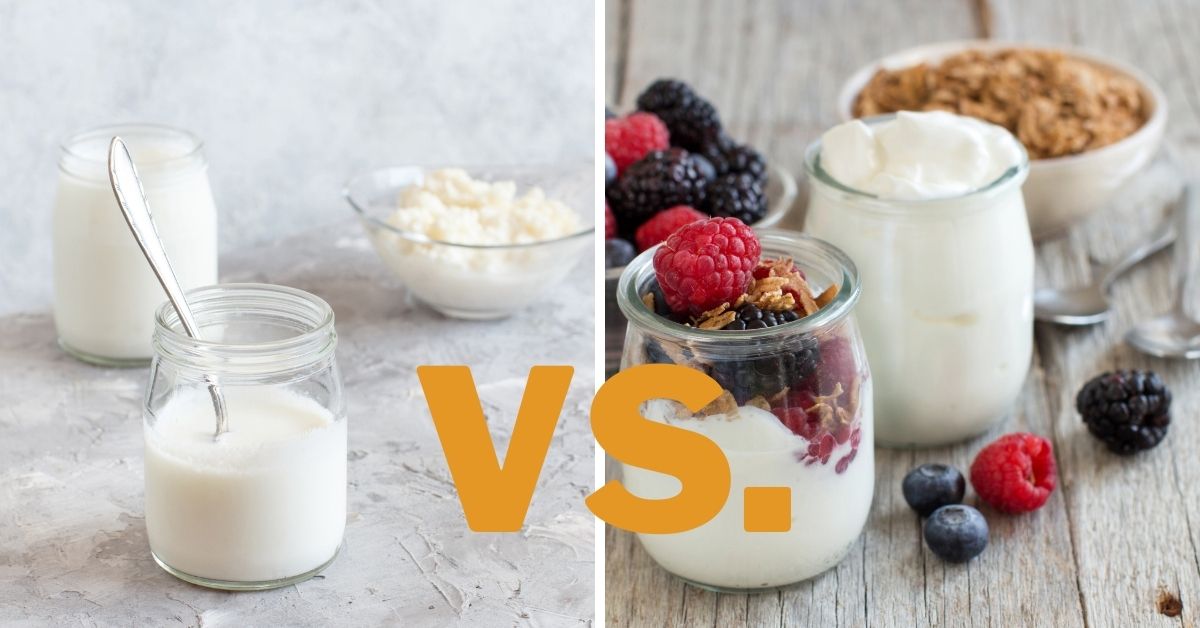Kefir vs. Greek Yogurt: Differences & Which Is Better?

Today’s topic will be two unique probiotic dairy products: kefir and Greek yogurt. Very high in macronutrients, those dairies are our great ally of the human body. However, they are not very similar to each other. So, what is the difference between kefir and Greek yogurt?
Kefir is a natural probiotic, and it is similar to buttermilk in its texture. It helps digestion and fights several bacteria. Greek yogurt also has some natural probiotics, but the consistency is thicker, and the taste is very fresh. Greek yogurt is richer in proteins than kefir. However, scientific research shows that, overall, kefir is better.
In this article, you will find everything you need to know about both products based on scientific data. I will also show you some examples of how I use both of these dairy products and explain to you why is kefir better than greek yogurt.
Kefir vs. Greek Yogurt: Differences
Nutrition
The composition of kefir is variable and not well defined. Nutrition depends on the fat content of milk, the composition of the grains, and the technological process of kefir.
Kefir has 70 kcal in 100 ml, and it shares the same level of protein and fat, 4,17 g each. [1] When it comes to carbs, a good amount of it is present, 4.58g. In addition, kefir is rich in vitamins and minerals, including iron, sodium, and vitamin A, but also 14 mg of cholesterol. So overall, the nutritional values are very beneficial for our bodies.
Almost the same calories are found in Greek yogurt, 73 kcal in 100 ml. [2] This yogurt has lactose, a considerable amount of protein, 9,95 gr, and is very rich in minerals compared to kefir. Calcium, potassium, phosphorus, and magnesium are only some of the minerals present in Greek yogurt. As you can see, Greek yogurt is an extremely rich dairy product.
Effects
Kefir is an antic dairy product originating from the Caucasus region 2000 years ago. Due to its fantastic health benefits, it’s known worldwide now. Kefir brings a lot of advantages to our bodies.
Firstly, it helps digestion and fights the bacteria in the human body. In addition, its effects include anti-inflammatory effects, antioxidant activity, and anti-allergenic activity. Nowadays, studies are directed toward obesity and metabolic disorders and it is believed that kefir may also reduce those metabolic diseases.
Greek yogurt also has its role in the muscle building as protein is the most essential macronutrient. It also contains a large quantity of calcium that strengthens the bones. Greek yogurt can lower blood pressure and the risk of type 2 diabetes. [3]
Taste
Kefir is made from the fermentation of kefir grains which provide, among others, unique organoleptic characteristics. As a result, the most dominant flavor is acidic and tangy but refreshing in the mouth.
Also, kefir can be fizzy and with a tart flavor due to those grains. It has similarities with the taste of regular yogurt, but it misses the slightly sweet aftertaste you find in regular yogurt.
As per Greek yogurt, the taste is also similar to regular yogurt; however, because the yogurt is thicker, it feels creamy and mouthfeel. It is not very sugary, but also not acidic. What stays as an aftertaste is just freshness, and it leaves you with the desire to ask for more.
Uses
As kefir is a natural probiotic, it is entirely safe to drink. Due to the low cost of production and simplicity, you can produce it at home by yourself.
Kefir is a good substitute for buttermilk, so you can feel free to use it for baking in the same way you would use buttermilk. For example, it would work nicely for pancakes, muffins, and cookies. Smoothies are another recipe that accepts kefir without destroying the taste.
Kefir is easy to digest, so it is a good fit for individuals who have difficulties digesting other lactose products. So if you are lactose intolerant, kefir may be an excellent substitute for yogurt. However, it is important to stay careful with the amounts. [4]
Kefir can also be used as regular milk: in cereals, salad dressings, or to prepare probiotic ice cream and smoothies. You only need to use your imagination.
One of my favorite uses of Greek yogurt is as an interchange for creme fraiche. I love to mix Greek yogurt with some fresh herbs, nutmeg, olive oil, and Aceto balsamico. You can use it in all fajitas recipes, to accompany the nachos or nuggets, or baked potatoes.
As already mentioned, it has a good protein level, so you can include it in your menu to build muscular mass. Likewise, a good quantity of Greek yogurt will add value to your meal in your healthy bowls of rice or beans. Many people also eat it with oats and berries.
Greek yogurt is also a perfect substitute for mascarpone cheese. Imagine this: want to prepare some desserts, but you don’t want to have mascarpone because of its fat. In this case, many recipes accept this interchange and the results are going to be great.
Also, it can be used as a digestive product to help your metabolism not get irritated at any meal.

Texture
Kefir has an atypic texture, as is something liquid mixed with some grains. The consistency should be very similar to buttermilk, which means anytime you use it, you need to shake it. Although, the texture is very flexible to the environment, so be careful not to change the temperature of kefir drastically.
Greek yogurts, compared with kefir and other yogurts, are thicker. It is a creamy mass that cannot be drunk like kefir can. In different brands, Greek yogurt can be almost solid and in other cases may be in a pudding-like form.
Finally, here is the table that sums up the differences between kefir and Greek yogurt.
| Differences | Kefir | Greek yogurt |
|---|---|---|
| Nutrition Values | Share the same quantity of protein and fat. Rich in calcium, Vitamin A | High in protein. Rich in phosphorus, potassium, vitamin B-6, B-12 |
| Taste | Acidic and tangy | Fresh and mouthful taste |
| Uses | For smoothies. | To get the protein dose; as a mascarpone substitute; as a dip for several recipes. |
| Effects | Helps digestion, fights the bacteria, anti-inflammatory effects, antioxidant and anti-allergenic activity. | Boost immunity system, strengthen bones, reduce the risk for type 2 diabetic |
| Texture | Liquid mixed with grains. It needs to be mixed before consumed | Exceptionally thick, sometimes almost solid. |
Kefir vs. Greek Yogurt: Which Is Better?
In an analysis based on scientific research related to both products, it looks like kefir has more health benefits than Greek yogurt. Studies have proved that this product has a direct effect on our metabolism. Nowadays, scientists are trying to understand kefir’s contribution to diseases like eating disorders.
Another advantage of kefir is that the probiotics in kefir are entirely natural. In Greek yogurt, it depends on the producer, as they may have a small number of natural probiotics and some other added probiotics to increase the values.
Which Has More Protein Kefir or Greek Yogurt?
Both products have excellent benefits for the human body. When talking about protein, Greek yogurt has a dominant quantity compared with kefir. A 100 ml of Greek yogurt obtains 9,95 gr of protein, while kefir has 4,17 gr. So Greek yogurt has two times more protein than kefir.
This significant difference is caused due to the way of production of Greek yogurt. A high protein product is obtained by removing the lactose and natural sugars from it, not only compared with kefir but also with regular yogurts in the market.
Can You Substitute Kefir for Greek Yogurt?
It depends on the purpose you want to interchange them.
If you want to consume a raw drink or eat, I would say yes. However, sometimes the same product in your diet can be tedious and become difficult to eat. So changing them with each other can be acceptable as both contain excellent health benefits.
Greek yogurt is better if you are using it for specific purposes: for example, to get the dose of protein so an interchange won’t bring the desired result.
Also, if you want to prepare a specific recipe, their usage is entirely different. For example, kefir can be used in milkshakes or to bake. In contrast, Greek yogurt is used more like a dip or cheesecake cream.
One point where they can be used for the same purpose is cereals. Most people consume cereals with kefir or milk, and I prefer Greek yogurt.
